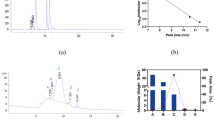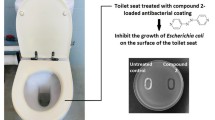Abstract
Zizania latifolia is a perennial herb belonging to the family Gramineae that has been used as a health food in Asian countries. In this study, we investigated the antimicrobial effect of Z. latifolia, which increased human beta-defensin 2 (hBD2) expression in HaCaT cells. hBD2 expression was further increased in cells treated with Z. latifolia extracts and subsequently infected with Staphylococcus aureus. Inversely, S. aureus infection decreased after treatment. The induction of hBD2 in HaCaT cells was mediated by the Toll-like receptor 2 (TLR2) signaling pathway, including the activation of extracellular signal-regulated kinase (ERK) and activator protein 1 (AP-1). Further study using siRNA revealed that hBD2 played an important role in the inhibition of S. aureus infection in HaCaT cells. Our data suggest that Z. latifolia extracts can be used as an antimicrobial ingredient for skin treatment formulas.
Similar content being viewed by others
References
Brown, J., Wang, H., Hajishengallis, G.N., and Martin, M. 2011. TLRsignaling networks: an integration of adaptor molecules, kinases, and cross-talk. J. Dent. Res. 90, 417–427.
Bunikowski, R., Mielke, M.E., Skarabis, H., Worm, M., Anagnostopoulos, I., Kolde, G., Wahn, U., and Renz, H. 2000. Evidence for a disease-promoting effect of Staphylococcus aureus-derived exotoxins in atopic dermatitis. J. Allergy Clin. Immunol. 105, 814–819.
Corrales-Garcia, L., Ortiz, E., Castañeda-Delgado, J., Rivas-Santiago, B., and Corzo, G. 2013. Bacterial expreßsion and antibiotic activities of recombinant variants of human β-defensins on pathogenic bacteria and M. tuberculosis. Protein Expr. Purif. 89, 33–43.
da Silva, L.C.N. and Correia, M.T.S. 2014. Plant lectins and Toll-like receptors: implications for therapy of microbial infections. Front. Microbiol. 5, 20.
Gambichler, T., Skrygan, M., Tomi, N.S., Othlinghaus, N., Brockmeyer, N.H., Altmeyer, P., and Kreuter, A. 2008. Differential mRNA expression of antimicrobial peptides and proteins in atopic dermatitis as compared to psoriasis vulgaris and healthy skin. Int. Arch. Allergy Immunol. 147, 17–24.
Goh, C.L., Wong, J.S.Y., and Giam, Y.C. 1997. Skin colonization of Staphylococcus aureus in atopic dermatitis patients seen at the National Skin Centre, Singapore. Int. J. Dermatol. 36, 653–657.
Gong, J.Q., Hao, L.L.T., Zeng, F.Q., Bi, Z.G., Yi, D., and Zhao, B. 2006. Skin colonization by Staphylococcus aureus in patients with eczema and atopic dermatitis and relevant combined topical therapy: A double-blind multicentre randomized controlled trial. Br. J. Dermatol. 155, 680–687.
Han, S.F., Zhang, H., and Zhai, C.K. 2012. Protective potentials of wild rice (Zizania latifolia (Griseb) Turcz) against obesity and lipotoxicity induced by a high-fat/cholesterol diet in rats. Food Chem. Toxicol. 50, 2263–2269.
Ho, S., Pothoulakis, C., and Koon, H.W. 2013. Antimicrobial peptides and colitis. Curr. Pharm. Des. 19, 40–47.
Klotman, M.E. and Chang, T.L. 2006. Defensins in innate antiviral immunity. Nat. Rev. Immunol. 6, 447–456.
Kumar, A., Zhang, J., and Yu, F.S. 2006. Toll-like receptor 2-mediated expression of beta-defensin-2 in human corneal epithelial cells. Microbes Infect. 8, 380–389.
Lacey, K.A., Geoghegan, J.A., and McLoughlin, R.M. 2016. The role of Staphylococcus aureus virulence factors in skin infection and their potential as vaccine antigens. Pathogens 17, E22.
Lee, S.S., Baek, Y.S., Eun, C.S., Yu, M.H., Baek, N.I., Chung, D.K., Bang, M.H., and Yang, S.A. 2015. Tricin derivatives as anti-inflammatory and anti-allergic constituents from the aerial part of Zizania latifolia. Biosci. Biotechnol. Biochem. 79, 700–706.
Li, Q., Kumar, A., Gui, J.F., and Yu, F.S. 2008. Staphylococcus aureus lipoproteins trigger human corneal epithelial innate response through Toll-like receptor-2. Microb. Pathog. 44, 426–434.
Li, D., Lei, H., Li, Z., Li, H., Wang, Y., and Lai, Y. 2013. A novel lipopeptide from skin commensal activates TLR2/CD36-p38 MAPK signaling to increase antibacterial defense against bacterial infection. PLoS One 8, e58288.
Mogensen, T.H. 2009. Pathogen recognition and inflammatory signaling in innate immune defenses. Clin. Microbiol. Rev. 22, 240–273.
Noble, W.C. 1998. Skin bacteriology and the role of Staphylococcus aureus in infection. Br. J. Dermatol. 139, 9–12.
Ricci-Azevedo, R., Roque-Barreira, M.C., and Gay, N.J. 2017. Targeting and recognition of Toll-like receptors by plant and pathogen lectins. Front. Immunol. 18, 1820.
Sajic, D., Asiniwasis, R., and Skotnicki-Grant, S. 2012. A look at epidermal barrier function in atopic dermatitis: Physiologic lipid replacement and the role of ceramides. Skin Therapy Lett. 17, 6–9.
Seelinger, M., Popescu, R., Seephonkai, P., Singhuber, J., Giessrigl, B., Unger, C., Bauer, S., Wagner, K.H., Fritzer-Szekeres, M., Szekeres, T., et al. 2012. Fractionation of an extract of Pluchea odorata separates a property indicative for the induction of cell plasticity from one that inhibits a neoplastic phenotype. Evid. Based Complement. Alternat. Med. 2012, 701927.
Unitt, J. and Hornigold, D. 2011. Plant lectins are novel Toll-like receptor agonists. Biochem. Pharmacol. 81, 1324–1328.
van Kilsdonk, J.W.J., Jansen, P.A.M., van den Bogaard, E.H., Bos, C., Bergers, M., Zeeuwen, P.L.J.M., and Schalkwijk, J. 2017. The effects of human beta-defensins on skin cells in vitro. Dermatology 233, 155–163.
Vargues, T., Morrison, G.J., Seo, E.S., Clarke, D.J., Fielder, H.L., Bennani, J., Pathania, U., Kilanowski, F., Dorin, J.R., Govan, J.R., et al. 2009. Efficient production of human beta-defensin 2 (HBD2) in Escherichia coli. Protein Pept. Lett. 16, 668–676.
Wang, B., McHugh, B.J., Qureshi, A., Campopiano, D.J., Clarke, D.J., Fitzgerald, J.R., Dorin, J.R., Weller, R., and Davidson, D.J. 2017. IL-1ß-induced protection of keratinocytes against Staphylococcus aureus-secreted proteases is mediated by human ß-defensin 2. J. Invest. Dermatol. 137, 95–105.
Wang, M., Zhao, S., Zhu, P., Nie, C., Ma, S., Wang, N., Du, X., and Zhou, Y. 2018. Purification, characterization, and immunomodulatory activity of water extractable polysaccharides from the swollen culms of Zizania latifolia. Int. J. Biol. Macromol. 107, 882–890.
Zollner, T.M., Wichelhaus, T.A., Hartung, A., Von Mallinckrodt, C., Wagner, T.O., Brade, V., and Kaufmann, R. 2000. Colonization with superantigen-producing Staphylococcus aureus is associated with increased severity of atopic dermatitis. Clin. Exp. Allergy 30, 994–1000.
Author information
Authors and Affiliations
Corresponding authors
Rights and permissions
About this article
Cite this article
Kang, B.Y., Lee, SS., Bang, MH. et al. Water-based extracts of Zizania latifolia inhibit Staphylococcus aureus infection through the induction of human beta-defensin 2 expression in HaCaT cells. J Microbiol. 56, 910–916 (2018). https://doi.org/10.1007/s12275-018-8307-9
Received:
Revised:
Accepted:
Published:
Issue Date:
DOI: https://doi.org/10.1007/s12275-018-8307-9




